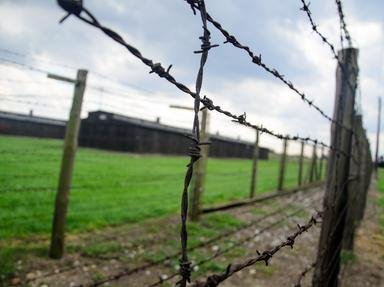Quiz Answer Key and Fun Facts
1. The "Yad Vashem Law" was established by the Israeli Knesset (parliamentary legislative body) in 1953. What was the purpose in establishing this law, as it applied to Holocaust victims?
2. This Jewish man, who was known by the pen name "Janusz Korczak", was a Polish Jew whose real name was Henryk Goldszmit. While not listed as "Righteous Among The Nations" (since he was Jewish), he served as the director of a Polish orphanage. In what manner did he assist the children of the orphanage during the Nazi occupation of Poland?
3. An eight year old Jewish boy named Raymond Aron survived the war and was later able to reunite with his family, which also survived the years of the Holocaust's uncertainties, due to the efforts of Germaine and Charles Bonnewijn and their son, Georges.
Based on their surname, can you determine what nationality the Bonnewijn's were?
4. Who is the *only* Nazi party member to have been honored with burial at Mount Zion, just outside the Old City walls in Jerusalem, Israel?
5. José Arturo Castellanos Contreras? Now, that is not a very likely name for a European rescuer of Jewish humanity during the Holocaust, is it? Well, that's because of this unsung hero's nationality. He is the only person from this non-European nation to be honored as one of the "Righteous Among The Nations".
From what country in the western hemisphere was he from?
6. You don't mean it!
A German who survived 11 years as a prisoner, mostly in Auschwitz, became listed as one of the "Righteous Among The Nations"?
Ludwing Wörl served as a doctor's orderly and was instrumental in diverting many ailing Jews from the gas chambers. What "undesirable" category of prisoner was he?
7. Physicians Kurt and Ella Lingens, along with a man who had a Jewish mother, Baron Karl von Motesiczky, worked in tandem as they tried to help others escape the clutches of the Nazi political machinery. After their arrests what happened to them as a result of their actions?
8. The Bricklayer and the Chemist ...
An Italian bricklayer aided an Italian-Jewish chemist in Auschwitz III (Buna) by bringing bread and his own food ration to give to the chemist/prisoner every day for six months. He also once gave him a small patched vest that he wore in the camp at Auschwitz. The prisoner, who later became a famous author, Primo Levi, was given both material goods and moral support by which of the following men?
9. A Frenchman, named René Dumonteil, was instrumental in aiding two Russian-born Jewish brothers, Gustave and David Szwec, during the the German occupation of France. At what venue did René first meet Gustave?
10. Adolf Althoff's family had operated their own business since the 17th century, but when Adolf's older brother and sister took over the family business in 1939, Adolf began his own similar enterprise. What type of traveling career did he and his wife, Maria, run that provided shelter for nearly an entire Jewish family for several years during the Holocaust?
Source: Author
logcrawler
This quiz was reviewed by FunTrivia editor
bloomsby before going online.
Any errors found in FunTrivia content are routinely corrected through our feedback system.
